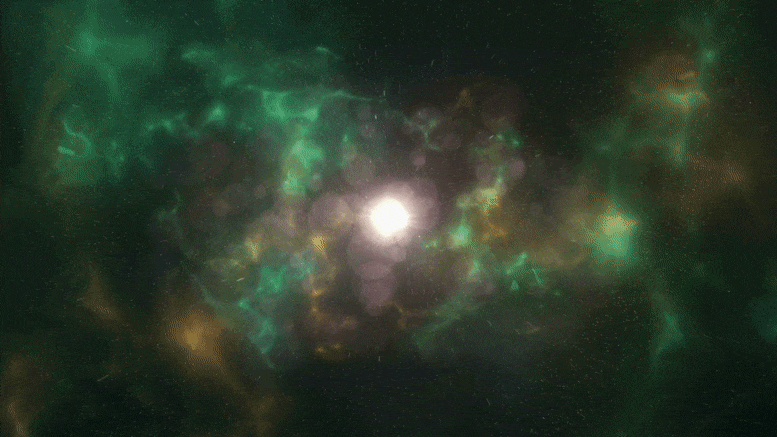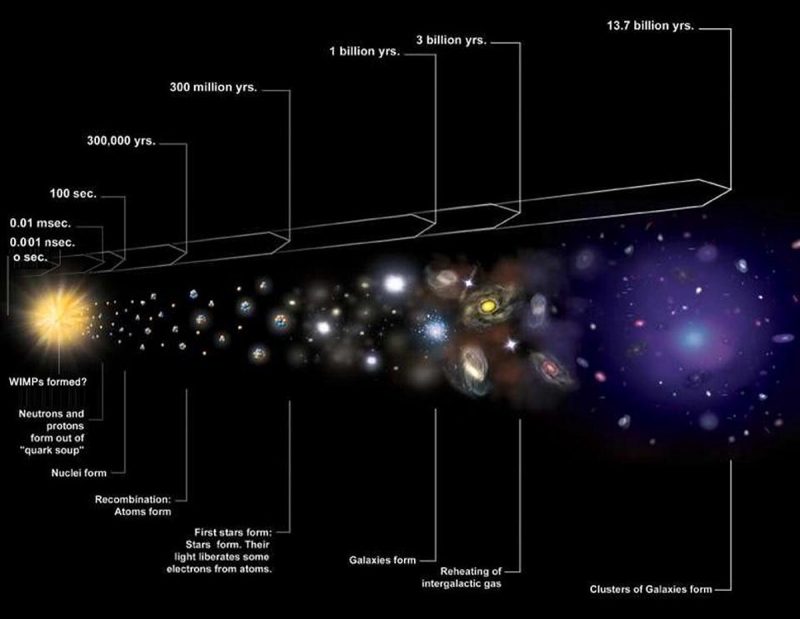
What was the universe like just after the Big Bang? Cosmologists probe basic physics during that earliest time using particle accelerators. The biggest one in the world is the Large Hadron Collider at CERN, a tunnel 17 miles (27 km) in circumference, deep underground beneath the border of France and Switzerland. On May 31, 2021, researchers said they used the Large Hadron Collider to investigate a specific kind of plasma present during the first millionth of a second – aka the first microsecond, or 0.000001 second – of the Big Bang. They said this plasma was the first matter ever to be present in our universe. And, they said, it had liquid-like properties.
The peer-reviewed journal Physics Letters B has published this new work online for its July 10, 2021, issue. You Zhou, together with his student Zuzana Moravcova, both at the Niels Bohr Institute at the University of Copenhagen, performed the work.
Quark–gluon plasma
Plasmas are sometimes called a fourth state of matter after solids, liquids and gases. The plasma in the earliest universe is called a quark–gluon plasma (QGP).
Modern researchers believe it was present in the first 0.000001 second of the Big Bang.
So imagine the state of matter in our present-day expanding universe. Then “run the movie backwards” in your mind, imagining all the galaxies getting closer and closer together as we look back in time. You might see that, during the first microsecond of the Big Bang, everything we know was crushed into an inconceivably small volume.
And perhaps you’ll also see that those first microseconds of our universe were incredibly hot and dense. It’s in this earliest time that we find the quark–gluon plasma. The video below, from Fermilab’s Don Lincoln, has more to say about this particular plasma.
Keep reading, to learn what the scientists at the Niels Bohr Institute learned about it.
Our universe’s 1st microsecond
The quark-gluon plasma (QGP) – present in the first 0.000001 second of Big Bang – didn’t stay around long. After those earliest moments, it disappeared as the universe expanded, becoming less hot and less dense. It’s a triumph of modern science that scientists can study the physics of this plasma using the Large Hadron Collider. Particle physicist You Zhou explained:
We have studied a substance called quark-gluon plasma that was the only matter which existed during the first microsecond of the Big Bang. Our results tell us a unique story of how the plasma evolved in the early stage of the universe.
First the plasma that consisted of quarks and gluons was separated by the hot expansion of the universe. Then the pieces of quark reformed into so-called hadrons. A hadron with three quarks makes a proton, which is part of [the cores of atoms].
These cores are the building blocks that constitute Earth, ourselves and the universe that surrounds us.
He explained how the Large Hadron Collider at CERN enabled researchers to recreate this first matter in history and trace back what happened to it:
The collider smashes together ions from the plasma with great velocity, almost like the speed of light [186,000 miles per second, or 300,000 km per second]. This makes us able to see how the QGP evolved from being its own matter to the cores in atoms and the building blocks of life.

A liquid-like form for the earliest matter
This team of scientists developed an algorithm that showed how the QGP expanded as the microseconds ticked by and the universe as a whole expanded. Their results showed that the QGP used to have a liquid-like form. The scientists said that it:
… distinguishes itself from other matters by constantly changing its shape over time.
Zhou commented:
For a long time researchers thought that the plasma was a form of gas, but our analysis confirm the latest milestone measurement, where the Hadron Collider showed that QGP was fluent and had a smooth soft texture like water.
The new details we provide is that the plasma has changed its shape over time, which is quite surprising and different from any other matter we know and what we would have expected.
He commented that, though this new work might seem like a small detail, it brings scientists a step closer to solving the puzzle of the Big Bang and of how the universe developed in its first microsecond.


Bottom line: Using data produced by the Large Hadron Collider, scientists say that in the Big Bang’s first microsecond quark-gluon plasma took the form of a liquid.
Source: Measurements of mixed harmonic cumulants in Pb–Pb collisions at √sNN=5.02 TeV











